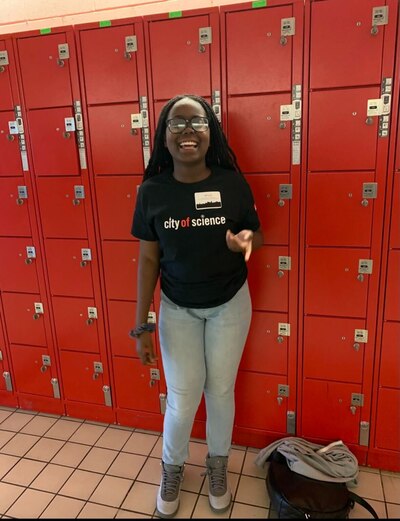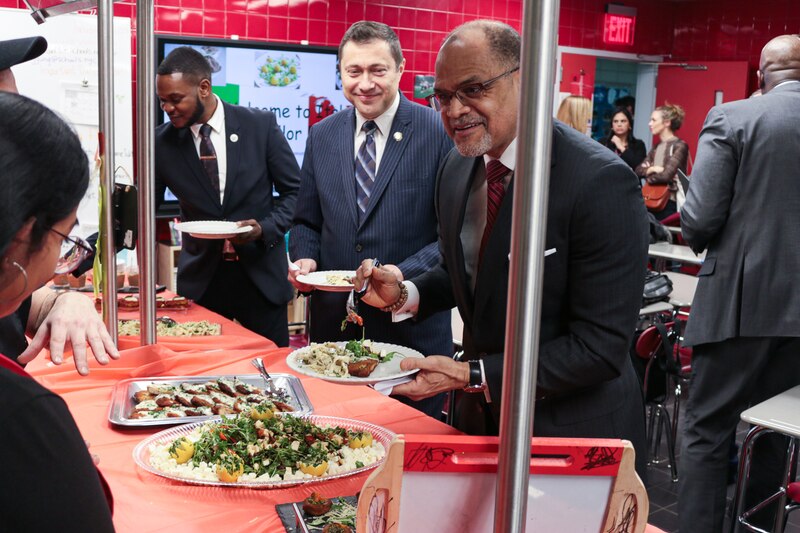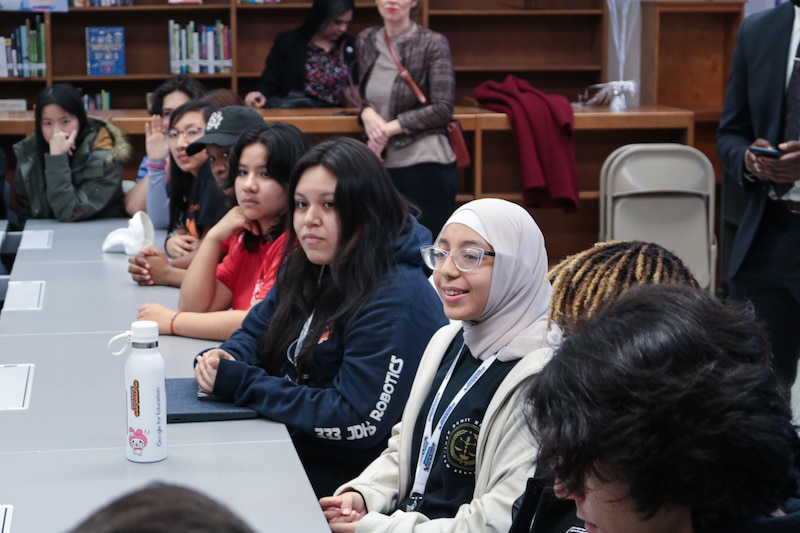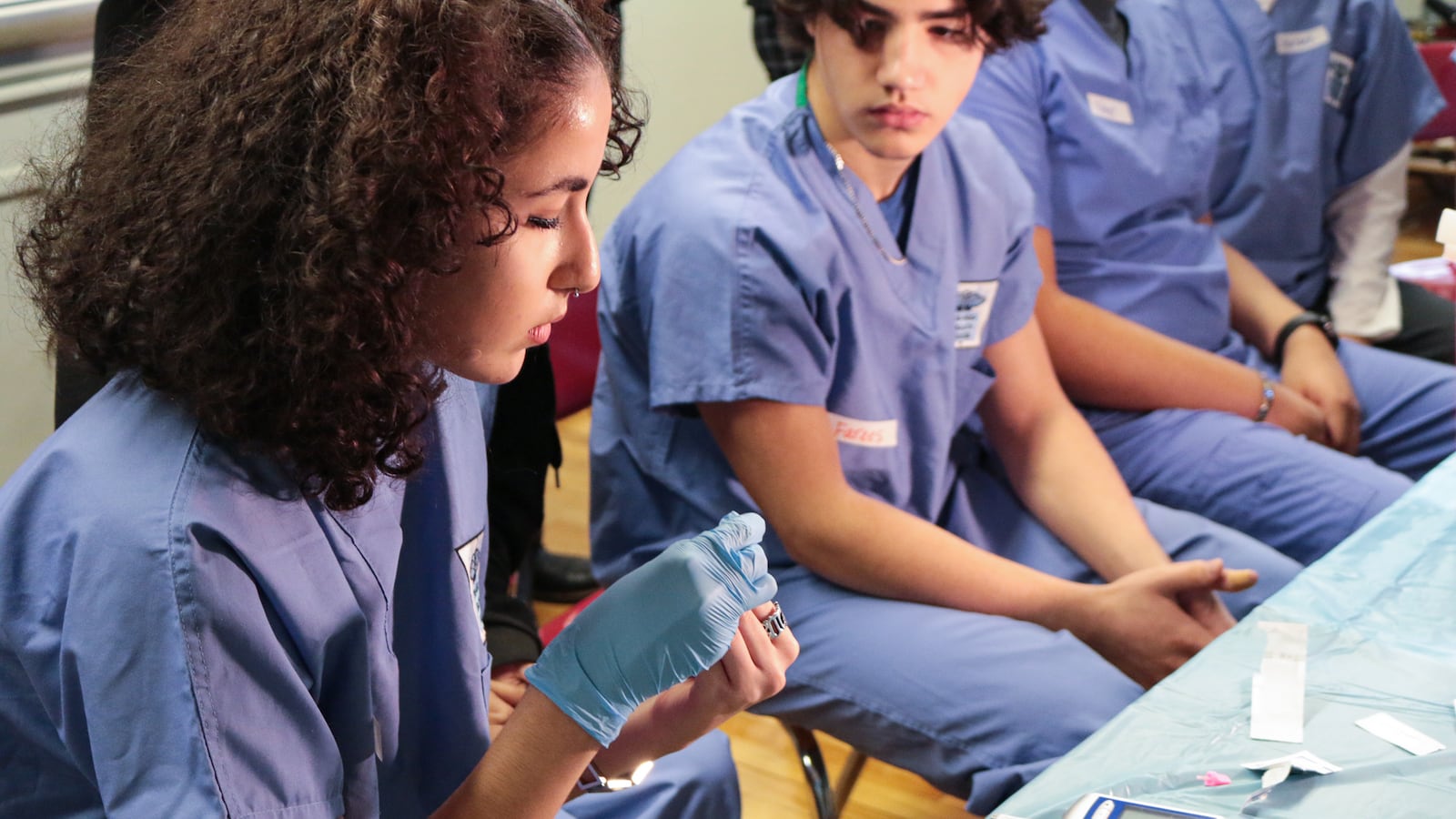Chalkbeat is a nonprofit news organization covering public education in communities across America. Sign up for our free New York newsletter to keep up with NYC’s public schools.
Afua Siaw dreamed of being a pediatrician. So when it came time to pick a high school, she chose the High School for Health Professions & Human Services — a decision based largely on the school’s name.
Siaw didn’t know when she applied five years ago that the Manhattan campus boasted a career and technical education program culminating with a chance to earn a medical assistant certification.
Her experience learning about front-line medical work turned her off to pursuing it as a career. But her school coordinated a virtual internship where she conducted survey research to help find solutions to local health disparities, sparking her interest in career possibilities beyond pediatrics.
“The internship kind of helped me realize there’s other aspects,” Siaw said. Now a Tufts University freshman, the 18-year-old plans to pursue psychology and public health.
Siaw’s experience is one that schools Chancellor David Banks is hoping to replicate across the system: jump-starting students’ exposure to career options well before graduation. Urban school districts across the country have increasingly embraced career and technical education programs, also known as CTE. Banks has described putting students on the path to stable careers as one of the “North Stars” of his administration, on par with improving literacy rates.

New York City has long been a leader in offering students a diverse range of CTE programs, with roughly a quarter of high schools offering at least one program, reaching about 60,000 students. Now, city officials are hoping to spread elements of the model to dozens more campuses. They plan to increase coursework focused on career skills, add new concentrations in fields ranging from education to health care, expand opportunities for early college credit, and offer more paid work opportunities before students leave high school.
The emphasis on career education represents a shift from the previous administration’s focus on college. Though college enrollment rates have risen, the share of New York City students staying enrolled for at least two years has not kept up, potentially leading to debt but not a degree. Meanwhile, nearly 18% of the city’s 16- to 24-year-olds are unemployed, more than double the national average. Young men and people of color are disproportionately out of work.
In an interview, Banks emphasized that college may still be the right path for many students. Plus, additional training or education beyond high school is essential for many careers. But he argued that the city’s public schools must better prepare students to transition to the workforce.
“What you’re seeing all across the nation, this idea that everybody’s just promoting college, college, college,” Banks said. “There’s got to be another way and another track and another pathway for kids to be successful.”
He believes career programs can help get students more excited about school and see themselves in professions they might not otherwise be exposed to.
“If this is done well, kids can come out of high school with credentials [and] certifications,” he said. “They can step right into the job market if they like.”
The goal: Paid apprenticeships and new career tracks
The city is banking on two pilot programs to create a stronger pipeline from high school to career opportunities, spending about $6.7 million this year on them.
The first, Career Readiness and Modern Youth Apprenticeship, will provide about 3,000 students at nearly 60 schools with apprenticeships for upperclassmen that pay up to $25 an hour. Ninth and 10th graders at those schools will participate in a curriculum that includes workplace skills such as resume-building, interviewing, and delivering an elevator pitch.

The first 500 apprenticeship slots — at companies like Amazon, Accenture, and MasterCard — will launch this fall, with students participating for up to three years, extending even beyond graduation.
The second program, FutureReadyNYC, gives schools resources to launch new career tracks, along with paid work experience, in education, technology, business, or health care. Schools will be expected to offer specialized coursework in at least one of those disciplines, early college credit through City University of New York partnerships, regular advising to help students transition to college or work, and instruction in financial literacy.
Though the program is still in a pilot phase, the education department is already planning to expand FutureReadyNYC beyond its current 66 schools. By next school year, it will include 7,000 students across 90 campuses, with the goal of reaching 40% of all high school students by 2030, said Jade Grieve, the education department’s chief of student pathways.
“We know that there’s more students that want to be in them than what we provide today,” Grieve said.
Principals flock to paid work opportunities for students
The programs are already proving popular with many school leaders who said they have often struggled to strike up relationships with relevant businesses or add courses for early college credit.
Dannielle Darbee, principal of the Brooklyn Academy of Global Finance, described the previous labor-intensive process of staff canvassing nearby businesses, hiring fairs, community board meetings, and other education department events for internship leads.
“We’ve always done it on our own, and that’s why it’s hard to find internships for students,” said Darbee, whose school is eligible for the new apprenticeships.
For the FutureReadyNYC program, schools that already have career programming have had an easier time hitting the ground running, according to several principals involved in the program. Thirty-two of the 66 schools that have been selected for the program already have at least one CTE program, officials said, while others are building from scratch.
At the Urban Assembly School for Emergency Management, the new pilot program is allowing the school to deepen its efforts. In addition to pre-existing placements in the city’s health department and emergency management agency, the city partnered the school with Northwell Health.
The healthcare provider is offering paid internships to more than a dozen of the school’s seniors this spring. A group of 10th graders recently visited Lenox Hill Hospital, where they had a chance to talk with medical staff and observe a robotic hip replacement surgery. And 11th graders are participating in a paid “workplace challenge” where they complete a project over several weeks.
“That industry relationship should not be undervalued — that’s a huge, huge thing,” said Michael Buchney, the schools work-based learning coordinator. “It’s so hard to build those relationships.”
The school is also beefing up its early college offerings. Instead of offering one college course focused on EMT training, the school now plans to offer up to seven college courses through the Borough of Manhattan Community College. The goal is to help students do their prerequisites for a paramedic-focused associate degree, enabling students to earn thousands more than they can with just the EMT certification, school leaders said.
“Kids are really invested in their future because of this,” said Dr. Rasheed Bility, the school’s principal. He added that he’s been impressed with the quality of the partnership with Northwell. “They’re not just doing meaningless work shredding paper at these internships.”

Still, many schools’ plans for creating new career tracks have yet to come into focus. In interviews with five principals who are part of FutureReadyNYC, nearly all said they were still figuring out what their new career pathways will look like. Some are still planning and education department officials said schools will have three years to fully launch.
Darbee, the Brooklyn Academy of Global Finance principal, said her school is focused on bolstering its current business CTE program and used some of the pilot program funding to hire a second guidance counselor, with one focusing on ninth and 10th grade students. Schools in the pilot program are expected to provide counseling twice a year to help identify students’ career interests, figure out what credentials are necessary, and map out individual plans.
Other schools that have not previously invested heavily in career training are taking baby steps. At High School for Youth and Community Development in Brooklyn, Principal Marie Prendergast said she had previously been reluctant to embrace CTE programming, worrying it would cannibalize the school’s electives. But the pilot programs are allowing school leaders like Prendergast to adopt some elements of career education slowly, and school leaders said they have a fair amount of leeway.
Prendergast’s school is in the process of launching a technology career pathway. The focus for now is getting all students to take at least one semester of computer science coursework and broadening access to more artistic elements of technology, such as graphic design. She’s not yet sure what other coursework or work experiences will follow.
“There is some building the plane while it’s in the air,” Prendergast said. “That’s the nature of pilots.”
A ‘two-tiered’ CTE system?
Proponents of career and technical education have cheered the city’s emphasis on expanding elements of CTE to a broader array of schools.
But even those boosters acknowledge that scaling up career-related learning opportunities — particularly paid work experiences — won’t be easy. And as the city attempts to stretch some elements of the CTE model to more campuses, questions remain about whether the new programs will be less intensive, with schools using a hodgepodge of approaches.
State-approved CTE schools are widely considered the gold standard. Those programs involve strict requirements, including industry-specific teacher certifications, periodic state reviews of school curriculums, paid work experiences, and offer the chance for a special diploma designation.
Leo Gordon, the vice president for career and technical education for the city’s teachers union, said he supports the pilot programs. But he worries they could amount to a “two-tiered” system of career programs with widely varying standards. He noted, for instance, that official programs require seven CTE credits, while the new pilot schools must only provide four credits related to the career pathway.
“The more students that have access to career and technical education the better,” he said. Still, “We want to make sure all programs are high quality.”
But spinning up official state-approved CTE programs often takes several years and some schools have faced challenges navigating red tape. And state approval does not guarantee every element of the program will be implemented: Many CTE schools have struggled to line up paid work experiences, according to a recent report from New York University’s Research Alliance for New York City Schools.
John Widlund, the education department’s former executive director for career and technical education, emphasized that there are benefits to letting schools adopt a less intensive version of the model.
“The push in the past was more for the full CTE-type model, which was a tremendous commitment of time, energy, effort, and resources,” he said. “With the career pathways, it’s less intensive, but it’s also less costly. And it has the potential to reach more kids.”
For now, it remains to be seen exactly how many students the education department’s current efforts will reach — particularly the most intensive elements involving paid work opportunities.
An education department spokesperson said the city has secured “hundreds” of internships and work-based learning experiences for FutureReadyNYC, but did not provide a specific number. Even including the 500 apprenticeship opportunities that will launch in the fall, eventually scaling up to 3,000 within three years, the total represents a fraction of the students enrolled at the pilot schools. City officials say they eventually want to provide all students with opportunities to explore careers before graduation, though they have not laid out a blueprint for accomplishing that goal.
James Kemple, executive director of NYU’s Research Alliance, said it makes sense for the city to start with a smaller subset of schools to iron out any kinks before a broader expansion.
The city’s ambitions to scale up career-oriented learning opportunities, including paid experiences, may be “one of the largest undertakings ever in the history of career and technical education given the size of New York City,” Kemple said.
“Whether they’re going to pull that off eventually at the kind of scale they’re talking about,” he added, “is another question.”
Alex Zimmerman is a reporter for Chalkbeat New York, covering NYC public schools. Contact Alex at azimmerman@chalkbeat.org.

